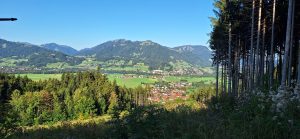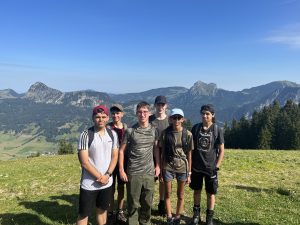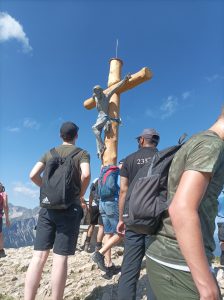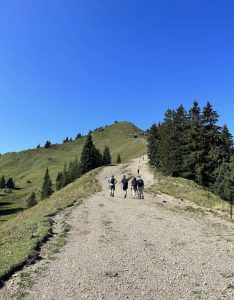Main Expedition
Day 1 – Acclimatisation Walk
The main expedition began with a day walk acclimatisation day. The cadets were split into 4 groups with routes up and around the Grunten. The Grunten overlooks the lodge and is at the foothold of the Alps; its peak stands at 1738m and can be seen for miles around and easily recognised with the TV/Radio mast on its peak. This was a challenging day for the cadets, not only due to the physical test, but also the environmental factors. This was the first time some cadets had achieved a mountain, but also achieving this in an astonishing 30-degree heat.
This was one of the clear examples where the teams looked after each other. This included
both boosting each other’s morale when the climb became difficult, to ensuring each member of the expedition remained hydrated and the team stayed together.
See Annex A for cadets’ responses
Day 2 – Neuschwanstein Castle
On this day, the expedition had a cultural day visit to the Neuschwanstein Castle. This is famously known as the ‘Chitty Chitty Bang Bang Castle’ as it was the set for the 1968 movie and theatre production. The cadets and staff were all given an expedition t-shirt to wear on the activity to highlight the expedition to others, making a greater awareness of the expedition and the purpose.
This was an ideal opportunity to introduce the expedition to the history and culture of Bavaria, not only due to the movie, but the history of the castle i.e., who built it and why. Neuschwanstein Castle is a 19th-century historicist palace on a rugged hill of the foothills of the Alps in the very south of Germany, just north of Austria. The views once again were breath taking. The guided tour around the castle was very interesting and gave an insight as to how King Ludwigs mind worked with his total influence in its architecture and room designs.
The cadets thoroughly enjoyed this activity and we had reports of cadets sitting with locals
at lunchtime, interacting further and exploring the culture. Some of the expedition picked up key words from this opportunity and they were able to introduce both themselves and
the organisation.
The cadets took the advantage to show other tourists that quality and calibre of the youth from the United Kingdom and this was well received.
Following the castle visit, a stop was made in the local Town, ‘Fussen’, for a brief stop for shopping and experience the outdoor cafés etc. Fussen is a very popular tourist destination with lots of history. It was also used as a film location for the all-time 1960’s movie classic ‘The Great
Escape’. This gave the cadets the chance to practice their new basic language but also to taste the delicacies of Bavaria, expanding their own pallet and openness to new food experiences. The ‘coffee and cake’ experience was enjoyed by all.
Finally, the cadets were taken to the local swimming baths to cool down. This also gave
the expedition the opportunity to recheck swimming competence prior to the white-water rafting in the coming days.
See Annex B for cadets responses Day 3 – Day Walk
Unfortunately, due to a cadet that had fallen unwell, as well as a dynamic risk assessment due to the heat on this day, the day walk was cancelled.
This was a slight test of resilience for the expedition as it was frustrating not to be able to achieve a second mountain on the expedition, however there was a clear understanding of both staff and cadets of the priority in safety.
On this day, the expedition changed to a brief trip on a cable car to the local café that has been in service for over 50 years. The café is immediately at the top of the cable car and has representation of the history of the local town and a lookout which gave a 360 view overlooking towns, distant mountains and spectacular glacial valleys. This was an amazing experience for the cadets to see how the town has expanded over many years to be able to host the expedition.
This was great opportunity for the cadets to look at the maps in detail, orientating them and setting them to the terrain surrounding them. Looking North we could see the ridge where the Gold DofE team would be coming over later that day and to the east the campsite, they would be stopping at on the bank of the Haldensee. The peak was also the launch area for paragliding, giving the group an insight to the preparation for running and jumping off a mountain top!
Following the gondola ride back down the mountain we returned to our Lodge and allowed the cadets some R and R for the rest of the day.
Following the trip, the temperatures had cooled somewhat and so it was an opportunity for the expedition to either relax or continue with sport and the team building experience.
See Annex C for cadets responses Day 4 – White water rafting
This day was probably the day that was the most anticipated by the cadets. The white-water rafting was an activity that only two cadets had done previously, which means this was a brand-
new experience.
The cadets were excited but also understandably nervous. More so when the cadets were beginning to hit the rapids. In regard to the training element for this, the cadets were asked to get out of their boat, and a few were reluctant to do so. However, after some encouragement by the remainder of the boat teams, they eventually climbed out of the boat and were able to successfully rescue
one another from the water. This boosted the individual’s personal confidence and independence for when the boats would hit the rapids. This is where the trust previously built within the teams became important.
After several rapids and numerous rallying activities with the crews, the rafting came to an end with some extremely thrilled cadets and staff. Amazed at not only the experience, but how they had surpassed their own fear and overcome them.
See Annex D for cadets’ responses Day 5 – Cycling & High ropes
This day included the cycling and high ropes activities. This was the first opportunity for some of the cadets to experience cycling outside of the training sessions delivered in the UK.
The cycling expedition was designed to build confidence with those that have had no or little experience, but to also challenge those with more experience.
Whilst the weather was warm, the challenge was to ensure the group remained together and worked together to achieve the task ahead.
See Annex E for cadets’ responses Day 6 – Cultural Visits
This was the final day of the expedition before departure home and is strategically placed.
The first element of the day was the BMW museum visit, where we got the chance to see the history of Germany through automobiles. The cadets were able to see both the past of the Country but also the future.
The second element of the day was the Dachau concentration camp. This is placed on the last day of the expedition to truly give the chance to reflect on the expedition and opportunities they had, balanced against why they have had this opportunity and the sacrifices made to ensure this.
The cadets were extremely humbled, and this was a fantastic opportunity to use the veteran of the expedition to discuss and explain this history and bring it to life.
The cadets both enjoyed the activity but also extremely grateful for the sacrifices made. See Annex F for cadets’ responses
Gold Duke of Edinburgh Expedition
Six cadets completed their Gold Duke of Edinburgh’s Award, walking approximately 60kms with over 3000m of accent in 4 days and crossing between the German and Austrian borders. Both the supervisor and assessor for the expedition were very impressed with the group’s preparation for the
challenge which not only pushed them physically but mentally too. The group were self-sufficient, carry everything they needed for their 4 days walking only filling up with water at the campsites each day.
The weather was hot at times which meant the group made the most of the cooler morning weather setting off on their daily 8-hour journey by 7am at the latest. The group worked well together each bringing their own different strengths to the team. Although the ascent up the mountains was challenging they found the view from the top breath-taking and well worth the climb. Their route took them through the picturesque villages and small towns, along the riverside and beautiful lakes as well as the welcome shade of the forests. Along the way they saw various animals including foxes and a family of deer who visited one of their campsites.
The team really embraced their expedition and learnt a lot about the Bavarian culture comparing this to their practice expedition in the UK. They have learnt so much about themselves and the fellow teammates over the 4 days in an adventure with memories that will last a lifetime.
Post Expedition
As part of the post expedition reflection, it is important to analyse the success indicators. So far, we have seen a massive change with cadet’s attitude and interaction within the local community.
Retention of cadets after the expedition
We have noted all expedition members are still active members of the organisation. This is rare as it can sometimes be seen after completing a once in a lifetime event, cadets leave the organisation.
We have witnessed this after the International Air Cadets Exchange and other expeditions abroad. Most cadets wish to attend 2025 in a support capacity. This includes 6 cadets that will age out by this time and wish to attend as staff with expedition qualifications.
Level of responsibility of cadets (being able to achieve high promotions)
All Squadrons have seen cadets return with much more confidence in their own abilities. This means cadets have been actively ‘acting up’ as leaders and Non-Commissioned Officers. This has proven to the expedition team, the confidence-building and the leadership skills have
advanced massively, including the essential teamworking element. It is not yet possible to measure the high-ranking promotions due to the closeness of the report, but feedback of staff identifies there are significant changes that show future promotions to above Sergeant as possible.
Level of Cadet volunteering in community projects
The Squadrons have seen many the expedition volunteering for further community events. This is in aid to support the Squadron with fundraising for itself and other charities. This is also for supporting community events which enable the community to come together such as the Leeds Marathon.
Number of cadets joining the military that attended the expedition
It is not yet possible to track this target, however we have noted two expedition members have attended and passed the first interview at the Royal Air Force Careers Office. When conducting interview practice with the individuals, it was noted the extent of which they discussed Bavaria, was
huge and enabled the cadets to really identify to the interviewer, how vast their skillset was through example and explanation.
Levels of cadet’s personal fitness levels and increase in taking part on Unit sporting activities including inter-squadron competitions
There have been no inter Squadron competitions since the expedition, however, it is noted a change in attendees’ fitness, through longevity. These cadets can take part for longer periods of time. We have also noted a large increase in expedition members signing up for the Duke of Edinburgh Award. This was not a specified target, but an amazing outcome of the expedition. The staff anticipate a 70% outcome for extra DofE enrolments.
Increase in number of cadets by using social media (advertising the event post activity)
Two of the Squadrons have held a recruitment evening at the beginning of September. The change in recruitment numbers has been massive. As part of the expedition there was a large social media project to advertise not only the expedition itself but also the organisation. Within two weeks of the return, there has been an increase of over 40 cadets across the units. This number is usually around
20. We feel that the activity feature has doubled our recruitment numbers. Monitoring the level of awareness of others within the unit
We have identified the level of empathy around the unit has increased amongst cadets. Also noting that the way in which NCO’s have dealt with disciplinary matters have changed; they are more engaging into the build of the incident and development moving forward as appose to strict discipline. This is an ideal motivator for the unit and additionally will reflect greatly in
the community. This will also have a massive effect on the individual and how they deal with problems in future life, work, and education.
The units have felt much tighter knit, and staff are of the impression this is down to the expedition. Level of individual volunteering – Away from the Squadron
We have identified 25% of the Squadrons volunteering a lot more for the community. An abundance of this is volunteering in schools for school council and community projects. This has shown the recognition of social responsibility. We have also noted an increase in volunteering within Squadron for more community events as appose to activities that solely benefit the cadet.
Cadets will present to other members of the Squadron and parents on return to demonstrate what they have done and what they have learnt about themselves
The Squadrons have each had a presentation evening to allow each expedition member to show what they have taken part in and most of all achieved from the expedition. On initial request, the Squadrons have a substantial uptake for EPIC 25, something we will be planning very shortly.
Develop levels of leadership in individuals
The units have seen a large increase in the attendee’s leadership abilities. This is stemming from the individual confidence in their own abilities. Interestingly, this includes massive personal confidence in newer cadets, which as shown previously, shows the potential for increased and advanced ranks
reaching by the cadets.
Several of the cadets have shown a clear interest in teaching others, and 12 cadets within 2 weeks of returning from the expedition attended a course on how to teach their fellow cadets. This allows them to pass on their experience and knowledge to the newer cadets within each unit and paves the way for the successful future of each Squadron.






